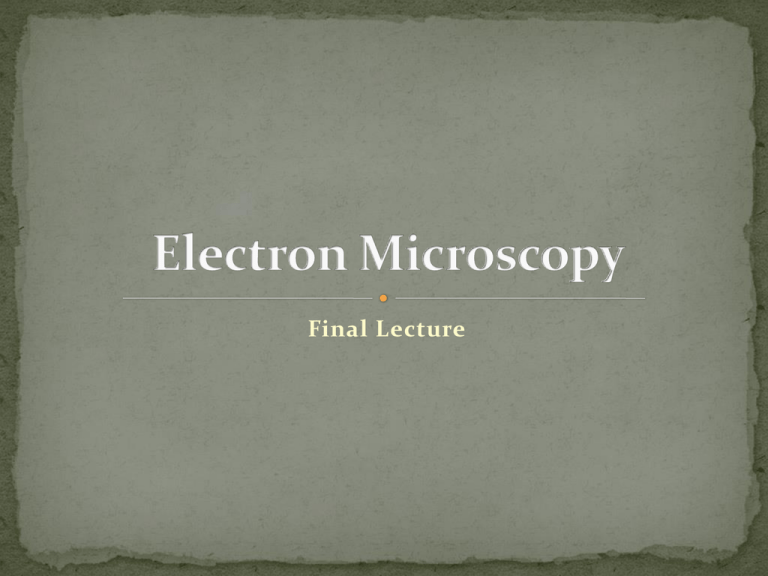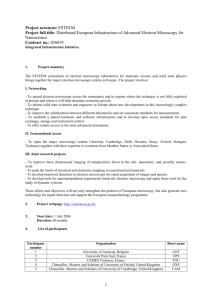Electron microscopy final lecture
advertisement

Final Lecture Electron microscopy in pathology Tumors Non-neoplastic conditions Applications of transmission electron microscopy Specialised ultrastructural techniques Human tissues or fluids containing human cells are sampled mainly for diagnostic purposes, i.e. for the identification of distinct categories of disease that can be recognized and treated by clinicians. A microscopically verified diagnosis is often necessary for optimizing patient management and, in the field of cancer at least, many purely clinical diagnoses are re-assigned investigation. by histopathological microscopical The light microscopical examination of haematoxylin and eosin (H&E)-stained sections of tissue embedded in paraffin wax is the most important technical procedure for human solid tissue diagnosis. While light microscopy of H&E sections remains the basis of histological diagnosis, newer techniques, such as electron microscopy (EM), immunohistochemistry, and ‘molecular’ techniques can now provide additional information understanding of disease and diagnosis. to refine our Diagnostic electron microscopy has been important since the late 1960s and early 1970s. The current literature testifies to the continuing value of EM in both research and the diagnosis of cases of human disease that are problematical by light microscopy. Whatever the numbers, EM should be applied whenever there is an interpretational difficulty in the H&E section. Further, EM and immunohistochemistry (and all the other newer techniques) should be seen as complementary i.e. both immunohistochemistry and EM can give a more complete picture of a lesion than either technique on its own. Nearly all ultrastructural transmission electron diagnostic microscopy work uses (TEM), to demonstrate specific or characteristic cellular and matrix features, which may enhance our understanding and diagnosis of disease (Tables 7 and 8). Tumours: In tumour diagnosis, successful characterization of a given tumour depends on finding its distinctive cell and/or matrix structures. A wide variety of tumours can be identified on the basis of their distinctive or specific ultrastructure (Table 7). Electron microscopy can also assist in suggesting the primary site of a metastatic. Finally, the value of EM in simple confirmation of a suspected diagnosis should not be underestimated. Diagnosing a lesion is not a black-and-white issue: pathologists hold diagnoses with a certain level of confidence, and this can be increased by an ultrastructural input. Tumours: A typical examination protocol is carefully to examine one block (one grid of ultrathin sections) for 1 hour. However, tumours with decreasing levels of differentiation may need more extensive searching several hours and multiple blocks, depending on the pathologist’s perception of the clinical need of the diagnostic result. Non-neoplastic disease: Currently, EM applied to non-neoplastic disease is perhaps in a more secure position than EM applied to tumours, since in tumour diagnosis, the primary objective is often the determination of the tumour’s cellular differentiation, in non-neoplastic disease there are many applications where multiple forms of structural change within a single organelle, cell or tissue can be identified (cilia, epithelium, striated muscle cell, peripheral nerve), which are indicative of different diseases. Non-neoplastic disease: EM has long had a value in identifying microorganisms. Among the most clinically significant in terms of numerical incidence are viruses. Other microscopic organisms can have their diagnosis confirmed or details of their structure revealed by EM: they include bacteria such as spirochaetes, protozoa such as Cryptosporidium, microsporidia and Leishmania (in AIDS), and fungi such as Candida. In addition to TEM, there are some, although far fewer, applications in what one might call ‘specialized’ techniques: scanning EM and other techniques (Table 9). Over the years, therefore, cell and matrix structures, which are distinctive or specific for a cell or a disease, have been identified and this accumulated mass of information forms the basis of diagnostic electron microscopy in both tumour and non-neoplastic disease (Tables 7 and 8). (Table 9) lists techniques which are designated as ‘specialised’ in that they are not as widely used in diagnostic laboratories as TEM, and which have fewer truly diagnostic applications. In many instances, the images from these techniques confirm a fairly secure diagnosis based primarily on clinical and histopathological findings, but they often nevertheless add new details, which can enhance the understanding of disease. They are clearly of potential value in research, and it should be remembered that research findings are sometimes precursors of diagnostic tests. These techniques tend to be found in diagnostic laboratories that may also have research responsibilities, where research has led to expertise in the technique, and personnel trained and experienced in the technique are on hand to exploit the technique in rare diagnostic questions when they arise. Scanning electron microscopy (SEM) SEM gives three-dimensional information, especially on surface features, and very often, therefore, the images are more easily interpretable (Figure 21a) than those from TEM. Scanning electron microscopy (SEM) Diagnostic applications of SEM are limited. They include the examination of human hair (Fig. 21a) and the identification of respiratory particulates, particularly asbestos fibres, which can also be studied by X-ray microanalysis for identifying chemical or elemental composition. The findings may have legal significance in connection with industrial exposure . (Figure.21):Special techniques—1. (a) Scanning electron microscopy. Human hair shaft. The patient was investigated for pili torti, where the hair shaft is twisted and fragile, but SEM analysis indicated trichorrhexis nodosa, with damage presumed to be due to mechanical or chemical trauma. (b) Immunoelectron microscopy. Immunoelectron microscopy Immunoelectron immunolabelling, microscopy (ultrastructural ‘immunoEM’) provides simultaneously the morphological data of conventional TEM and information on biomolecular composition as in light microscopical immunohistochemistry. Immunoelectron microscopy ImmunoEM data, like those from SEM, tend to be confirmatory, or add to the scientific understanding of a clinical condition. However, the potential of the technique to confirm a diagnosis, to remove some interpretational uncertainty and to enhance the confidence with which a diagnosis is held, is very great.




